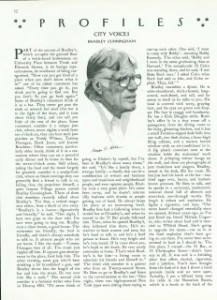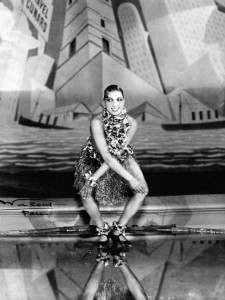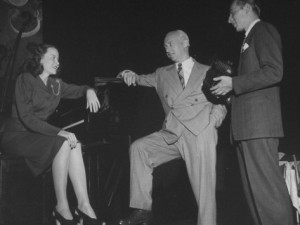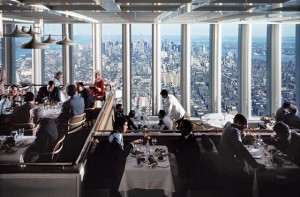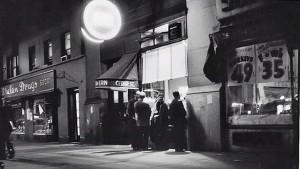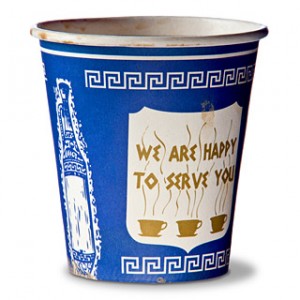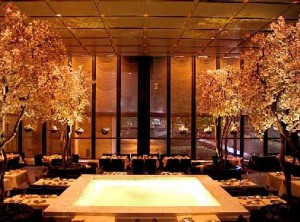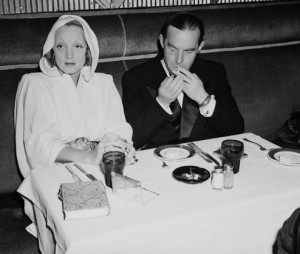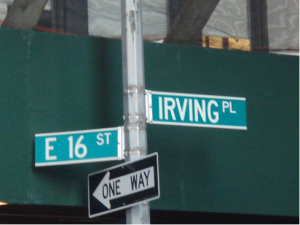Bradley’s, the intimate bar, restaurant and music venue on University Place, encouraged many HG and BSK smiles. It was small — 15 tables and 20 bar stools. The food — steaks and hamburgers — was honest and good; the music, however, was great. On a platform was a baby grand piano (contributed to Bradley Cunningham, the proprietor, by the great saxaphonist, Paul Desmond). The world’s greatest jazz pianists (sometimes accompanied by a bass) played there. Tommy Flanagan, Teddy Wilson, Jimmy Rowles and Kenny Barron were among them. Bradley made sure it was an orderly room where artistry could be appreciated and heard. (There was also some nice visual art in the room — three BSK acrylics were among the paintings over the bar). Bradley was a big, craggy- faced, ruggedly handsome guy (died of lung cancer in 1988). He was interesting. A fine amateur pianist and an appreciator of good writing and a true lover of New York. Served as a Marine in World War Two, learned Japanese and used that skill to talk Japanese soldiers out of indefensible bunkers and later interrogate them. He had witnessed much horror. He was in Nagasaki soon after its atomic bombing. Bradley and his friends, the great vocal and piano duo of Jackie Cain and Roy Kral (Jackie still performs occasionally. Roy died a few years ago) rented a Fire Island house near HG/BSK’s dune house and became dear friends of HG and BSK. HG encouraged Jackie and Roy to buy a house in Montclair, N.J., where HG lived. They did and HG and BSK would often drive into New York for an evening at Bradley’s or meet there late at night after theater or movies. Bradley married Wendy, the beautiful, long time waitress. HG and BSK joined Jackie and Roy at the wedding at a West Village church and had a celebratory meal at Leon Lianides’s Coach House House Restaurant on Waverley Place. Much joy. After Bradley’s death, Wendy kept his place alive until the final closing in 1996. Stanley Crouch wrote a lovely piece about Bradley’s in the New Yorker (Aug. 26, 1996). When Bradley was still alive, the jazz writer and critic, Whitney Baillet, did a full length profile of him in the New Yorker. You can access both pieces from the New Yorker archives. Do so.
University Place Free Association Part III: Bradley Cunningham
June 10th, 2013 § 2 comments § permalink
University Place Free Association Part II: Ivan Black and Barry Gray VS. Walter Winchell and the Stork Club
June 9th, 2013 § 2 comments § permalink
In 1951 Ivan Black, the press agent for the Cafe Society clubs, became involved in a bitter battle with Walter Winchell, the all-powerful columnist and radio personality. Josephine Baker, the New York raised, African American dancer who had become one of the most famous entertainers in France, went to the Stork Club — at the time, one of New York’s top clubs and celebrity hangouts. Ms. Baker felt she received rude service because of her race and she made her displeasure known. A radio talk show guy, Barry Gray, took up Baker’s cause and criticized Sherman Billingsley, the Stork Club proprietor. Billingsley was a Winchell pal (WW had a nightly table in the Club’s super-exclusive Cub Room). The battle was on: Barry Gray and Ivan Black VS the Stork Club and Walter Winchell. WW accused Baker of fascist sympathies and communist ties. (Baker sued WW for defamation — but the timid State Department refused her a visa for some years so she was unable to take the suit to court). WW characterized Barry Gray and Ivan Black (who was also the press agent for the restaurant where Gray broadcast) as “commie sympathizers.” In WW’s columns, Gray was ” Borey Pink” and Black was “Ivan Pink.” Such was Winchell’s power that Gray was hounded out of New York. He relocated to Miami where he was very successful and later returned to New York as a popular (and politically conservative) radio gabber. Today, he is acknowledged as the “Father of Talk Radio.” Ivan, a gentle and scholarly Harvard graduate, had some business reverses but survived. The Ivan Black papers at the New York Public Library (some 55 boxes of press releases, clippings, photos and musical scores) are an invaluable historical source for the night club and jazz scene in New York (1937-1978).
Winchell? Television destroyed him. His TV show was a flop. Soon his radio broadcast and column disappeared. With chagrin, he watched his old rival, Ed Sullivan, become a TV icon. (Yes, WW did voice overs on “The Untouchables” TV show but that was just nostalgia shtick). WW died, quite forgotten, age 74. HG is ambivalent about WW. Winchell liked the prose HG contributed to his column and gave HG clients favorable mention. HG’s career as a press agent got a jump start when Winchell printed, in bold face, a prose poem HG authored. WW sent HG a note: “Keep it comin’, keed–WW.” And that’s what HG has done for many a year.
As for Abel “Strange Fruit” Meeropol who was mentioned in Part I of the University Place posts: He and his wife adopted the two orphaned young sons of atom spies Julius and Ethel Rosenberg. Both boys grew up to be college professors. Their childhood with the Meeropols was a happy one. Abel, they recall, was a master of comic improvisations and impersonations. He kept them laughing. After the torment that those boys went through, HG is certainly thankful for that.
University Place Free Association Part 1: Barney Josephson
June 8th, 2013 § 2 comments § permalink
HG recently did a post on the good and bad sides of Cedar Bar the legendary hangout of abstract expressionist artists and their hangers on. Its location was University Place in New York’s Greenwich Village neighborhood. A meandering torrent of HG memories ensued. Let’s start with an omelette and burger joint, Cookery, on the corner of 8th and University Place. Food was adequate but secondary. Its renown was based on live jazz. Mary Lou Williams and Alberta Hunter were two of the club’s star performers. Opened in the 50’s and had an almost 30-year run. The owner was a Village legend, the elegant and courtly Barney Josephson. A remarkable guy, Barney was a race relations pioneer. In 1940, he opened a night club — Cafe Society Downtown — in a basement on Sheridan Square. First totally racially integrated — performers and audience — night club in New York and perhaps in the United States. Even the great Harlem clubs of the 20’s — the Cotton Club, etc. — were “whites only.” Yes, a few African-American were seated, but in obscure, hidden locations. Barney changed all that. With the legendary John Hammond acting as talent scout, Barney booked great jazz artists like Billie Holliday and Sarah Vaughan and fledgling stars like Lena Horne. He is also credited for starting the vogue for folk music in Greenwich Village by presenting Josh White. It wasn’t all music. There were laughs. Zero Mostel was the Master of Ceremonies and Imogene Coca and Carol Channing performed there. The club’s press agent, Ivan Black (more on him later), gave Mostel his odd first name: “Because he came from nothing.” A Bronx school teacher, Abel Meeropol (more on him later), approached Barney with a song he had written, Strange Fruit, a passionate, wrenching protest against the lynching of African-Americans. Billie Holliday sang the song and it was a smash. Barney had special rules for the song. It would end her set and there would be no encore. The club would go silent and there would be no service when it was sung. No lights but a baby spot on Holliday’s face. HG was too young for Cafe Society Downtown but heard Billie sing it at the Onyx Club on W. 52nd Street. Same presentation. Devastating. With the success of Cafe Society Downtown, Barney opened Cafe Society Uptown on E. 58th. Both clubs flourished. Then, disaster. Barney’s brother, Leon, was the lawyer for both clubs. A radical leftist (Leon was briefly jailed in Denmark in 1935 for joining in an unsuccessful plot to kill Hitler), Leon was called before the House Un-American Activities Committee at the height of the Red scare. Tough and defiant, Leon refused to testify and was cited for contempt. The Hearst newspapers and their columnists (Westbrook Pegler, Dorothy Kilgallen and Walter Winchell), declared war on
Josephson and the two clubs. Performers were cowed by threats their careers would end if they performed at “commie” clubs. People who patronized the clubs feared reprisals. By 1948 the clubs were gone. Barney was quiet for a while but soon got back in action by founding the Cookery chain. At one point there were five but Barney closed the other four so he could concentrate on the University Place location. The University Place Cookery closed in 1984 after reuniting Jospehson with many of the performers he had introduced at the original Cafe Society. In 1988 he died at 86.
Views
June 2nd, 2013 § 0 comments § permalink
HG and BSK have been very fortunate in life to have dined looking out at a variety of spectacular views. Of course, nothing will ever match the sweeping New York vistas from tragic, doomed Windows on the World Restaurant on the 105th and 106th floors of the World Trade Center. HG dined there often, managed news conferences and business meetings in its convivial setting. (One of HG’s business colleagues was among four people who left the restaurant and elevatored to safety just minutes before the terrorist plane struck). There are other New York restaurants, thankfully spared disaster, with great views: The glittering art-deco Rainbow Room in Rockefeller Center. The “Top of the Tower” in the Beekman Tower Hotel. In Italy, incredible views were matched with culinary delights: In a miniscule trattoria atop a lofty hill in Tuscany HG and BSk feasted on tagliatelle with generous shavings of white truffle. In Sicily there were extravagant aquatic vistas viewed from a dining terrace where the specialty was Spaghetti Norma (eggplant sauce). Also in Sicily, HG and BSK ate linguini with sardine sauce while seated on the terrace of a posh Taormina hotel, the endless blue of the Mediterranean shimmering in the distance. For many years, HG and BSK didn’t have to leave home to enjoy dining scenery. For some 16 years HG and BSK’s Colorado dining table faced some 75 miles of views including the Front Range of the Rockies, the lights of Denver, Pike’s Peak and the plains of Kansas. (The HG/BSK home was 9,000 feet above sea level). The HG/BSK loft in Vancouver looked over mountains, sea and glittering skyscrapers. Here, in New Mexico, HG and BSK dine with a crackling fire in their fireplace (nights are cool, even in May and early June) with Las Barrancas (the Cliffs) in the distance. These cliffs, which change color throughout the day as sun and shadow paint their surface, are on the land of the Poajque Pueblo. They are steeped in tribal history. Nice backdrop for HG and BSK’s wine accented dinners.
The Cedar Bar – The Good and The Bad.
May 21st, 2013 § 4 comments § permalink
The last remnants of the Cedar Tavern (always referred to as the Cedar Bar), 82 University Place in Manhattan’s Greenwich Village, are being demolished to make way for a waxing salon. Nostalgia can can cloud vision. But, not Lee Siegel’s vision. The writer has a very balanced account of Cedar Bar in a New York Times Op-Ed piece and comes to some surprising conclusions. Permit HG to review the Cedar Bar history. In the 1950’s and early 1960’s it was the hangout of the hard drinking, rambunctious New York school of abstract expressionists and other painters who became modernist icons — de Kooning, Rivers, Pollock, Kline, Guston, Motherwell, etc. Their presence attracted writers, film makers, poets, musicians and a motley crew of bohemians. It was a macho crew so there were plenty fisticuffs and alcohol fueled rage (and hilarity). Needless to say, misogynistic and homophobic language and behavior flowed free. Siegel points out that women were always treated badly. He quotes Lee Krasner, Jackson Pollock’s wife and an extraordinary painter in her own right: “I loathed Cedar Bar. Women were treated like cattle.” Gays were insulted and made uncomfortable. One saving grace of the Cedar was it was very inter-racial. It was a bar where HG always felt comfortable drinking with his African-American girl friends. (Yes, women were treated shabbily. But, not African-American women. The Cedar’s ferocious leftists saw to that.)
HG was a man of his time. HG loved the Cedar Bar and shared most of the nasty attitudes of its habitues. When HG lived in the Gramercy Park neighborhood (more than 50 years ago) HG had a Saturday routine. Little daughter Victoria (now the distinguished restaurateur — Five Points, Cookshop, Hundred Acres) was placed in her stroller and the duo was off on a stroll through 23rd Street (great bookshops), Gramercy Park (HG had a key for a short period), Irving Place (a grilled cheese sandwich for little Vicki at Pete’s Tavern), Washington Square Park and, as a final destination before returning home, Cedar Bar. Vicki was perched on the bar where she munched pretzels and peanuts and was admired by all for her remarkable blonde cuteness. As for HG, there were numerous martinis while HG participated in vigorous discussion. A very boozy and joyful afternoon indeed.
Greeks
May 11th, 2013 § 2 comments § permalink
In one of the great quirks of the American immigrant experience (think Chinese laundries, Indian motel monopolies, Korean grocers, etc.) Greeks have long been the dominant force in New York and New Jersey’s numerous diners and coffee shops and, in fact, in inexpensive dining establishments throughout the U.S. and Canada. The domination is so ubiquitous that the iconic New York take-out coffee cup was long emblazoned with illustrations of classic Greek art and architecture. Unlike fancy Greek fish restaurants (or traditional Greek restaurants), these diners and coffee shops are not gourmet destinations or particularly ethnic, but places where you can get a fast, square meal at a fair price. New Jersey’s Tick Tock Diner (famed for its “Eat Heavy” motto) has been in the news lately. Owned by a Greek family, the Tick Tock has never been a favorite of HG. However, its proximity to the Lincoln Tunnel and Meadowlands sports and entertainment complexes has made it popular (location, location, location). The news interest in the Tick Tock now is a case of murder. It seems the manager (relative by marriage) felt ill used by the head of the family (and Tick Tock boss) and hired a hit man to torture and kill the guy. As is often the case, the hit man was an undercover cop (with a nicely functioning) recording device. Too bad for the manager. HG’s favorite Greek greasy-spoon operator was Chris, a sweet, hard working guy who–some 60 years ago– ran a hole in the wall operation in the old Daily Mirror building at 235 E. 45th Street in New York. Chris had a thick Greek accent. This made him a favorite of Dan Parker, the Mirror sports columnist, who would often quote Chris as part of his humorous riffs on dialect. Chris fed the impecunious journalists, lithographers, pressmen and others who worked in the building the inevitable “cheeburger, cheeburger, cheeburger.” But, Chris also turned out great fried scallops and fried flounder. Splendid greasy French fries. Chicken livers and onions on rice. Other good things. Not too many vegetables, unless you count cole slaw as a veggie.
As a side note, it is fascinating that some of America’s great regional cooking from Cincinatti Chili to Rhode Island’s New York System wieners to Detroit’s Coney Island Hot Dogs can be directly traced to the blending of classic American food and traditional Greek flavor profiles (middle eastern spices, etc.).
Cheap New York & The Surrealists
March 20th, 2013 § 4 comments § permalink
The younger generation is disbelieving when HG mentions how cheap New York living used to be. In the 1950’s a quite liveable one room apartment in Greenwich Village or Chelsea rented for $35-45 a month. In the 40’s, a pastrami sandwich was 15 cents (later raised to 17 cents as wartime inflation took hold). The subway was a nickel and there were ferocious protests when the fare was raised to a dime. (Yes..everything is comparable and salaries were low then and inflation has risen…but still…New York was then an affordable, working and middle class city; now it is a city built for the rich with everyone else struggling to stay afloat). During the 1940’s HG’s beloved late sister Beulah Naomi would take young HG to lunch at Larre’s, a French restaurant on W.56th Street in order to give the young man a taste of European civilization. French was spoken at almost every table as wartime immigrants and high school French teachers paid homage to Francophone culture. This what you got for 50 cents: All the French bread you could eat, of course, plus a small, gratis salad. An hors d’oeuvre cart passed through carrying modest treats like lentils, shaved carrots, string beans. Soup (onion or consomme). A long simmered stew with a fancy French name (either beef or mature fowl). Dessert (usually custard described as “Creme Caramel”). Coffee. No, it was not Henri Soule caliber French food but it was okay. Beulah Naomi and HG didn’t know that during World War Two, Larre’s was the favorite restaurant of a group of artists. Robert Motherwell (then interested in surrealism) and other avant-garde visionaries would lunch at Larre’s twice a week with famed French surrealists displaced by the war — among them Marcel Duchamp and Andre Breton. After lunch, the group would stroll to Third Avenue, then filled with antique and second-hand furniture shops. They would browse these shops trying to determine which objects were “surrealistic.” Duchamp (who gave the world the first “ready-made” piece of art i.e. a hanging urinal) was the final arbiter.
Putting on the Ritz
February 1st, 2013 § 0 comments § permalink
HG has never enjoyed pricey, upscale, high cuisine restaurants. In many decades of dining, only four have given HG pleasure commensurate with the expenditure. One, Le Pavillon, in New York is long gone, but memories of their fillets of smoked eel topped with a horseradish-infused whipped cream will linger on the HG palate forever. Another, the Connaught Hotel Restaurant in London offered the quintessential civilized English dining experience — perfect Dover Sole (de-boned at the table), Stilton and Port to finish (with a cigar service for those who indulged – and HG did just that). Alas, the Connaught has changed so much that it is unrecognizable. Two, both in New York, are alive and well. One is Le Bernardin and the other is the Four Seasons Restaurant in the Seagram Building. Le Bernardin is flawless, simply the best seafood in the world prepared with flair and imagination. Fabulous wine list supervised by a renowned sommelier. Very, very expensive but not insane. Lunch Prix Fixe is $72 (three courses) and Dinner Prix Fixe is $127 (four courses). Tasting menu is more extravagant — $237 with paired wines. HG was a frequent diner at the Four Seasons during HG’s New York career. The Pool Room is the most beautiful restaurant space in the world. Curiously, New York big shots never ate there. They chose the more austere Grill Room. Menu is the same in both rooms. The Four Seasons used to be expensive but affordable for tax deductible meals. Now, the prices have gone through the roof. An appetizer of Spaghetti with Poached Egg and Black Truffles is $75. Grilled shrimp appetizer is $38. Venison, lamb chops, bison and steak are about $75. If you want to sample Four Seasons cuisine without going broke, take a seat at the bar. The Bar Menu is delicious and affordable (comparatively).
The Original Blue Ribbon
January 29th, 2013 § 14 comments § permalink
The Blue Ribbon was a German restaurant located in New York on W. 44th Street between Sixth and Seventh Avenues. (Don’t confuse it with the cluster of wonderful Blue Ribbon restaurants run by the Bromberg brothers). The original Blue Ribbon opened in 1914 (and managed to survive the World War One anti-German hysteria). Delighted robust eaters for many decades until it closed in 1975. Served all the traditional dishes (kassler ripchen, grilled wursts, wiener schnitzel,sauerbraten, sauerkraut, fried potatoes, etc.). A warm room paneled in dark wood. Comfortable seats and pleasant lighting. A perfect venue for lovers of hearty food washed down with the best of German beers. It was a favorite with Germans who had fled Hitler. (Plus some bad Germans — namely a wartime espionage ring which used the restaurant as a rendezvous before being captured by the FBI). HG dined there very often with journalists from the New York Times. The real estate editor, the late Glenn Fowler, was a frequent dining companion. He introduced HG to steak tartare. Glenn would mix it at the table with a host of ingredients — egg yolks, anchovies, chopped onions, capers, English mustard, Worcestershire sauce, salt, ground pepper and a dash of Tabasco. Very memorable. Best ever. The Blue Ribbon was a short walk from the original Madison Square Garden (50th and 8th Avenue) so it was an HG favorite for a snack after basketball, hockey or fights. HG would choose the apple pancake, a giant affair, at least 18 inches in diameter, oozing sauteed apples enriched with cinnamon, ginger and powdered sugar. Dark beers in chilled mugs within reach, HG and buddies argued about the athletic events. A frequent Blue Ribbon customer was Erich Maria Remarque. His novel, All Quiet On The Western Front, was one of the first books burned by the Nazis. He manged to avoid their clutches by escaping to Switzerland (his sister, Elfriede Schutz, wasn’t as fortunate — she was beheaded by the Nazis for “defeatism”). There are many mentions of the Blue Ribbon in Remarque’s novel about New York in the 1940’s, Shadows In Paradise. Remarque didn’t spend all his time writing and eating. He had a long affair with Marlene Dietrich and a shorter affair with Hedy Lamarr before marrying the beautiful actress, Paulette Goddard. Remarque’s name lives on in New York. Goddard gave New York University $20,000,000 to found the Remarque Institute of European Studies. Permit HG a digression. The first director of the Institute was the late Tony Judt. In HG’s opinion, Judt is the greatest historian of post-World War Two Europe. He was an engaged intellectual who wrote many penetrating studies of world affairs. If you want to have some understanding of the difficult world we live in, you must read his books.
Magical Irving Place
January 22nd, 2013 § 0 comments § permalink
Manhattan’s Irving Place is a short street, occupying the six blocks between Gramercy Park and East 14th Street. It has a colorful history and, like many New York streets, has gone through many changes. Lots of memories for HG. Pete’s Tavern (corner of Irving Place and East 18th) was a favorite of HG’s. Wonderfully old fashioned bar and booths (owners claim it was founded in 1864 making it the oldest continually operating tavern in New York). Many an HG date started in a booth at Pete’s with the couple sipping the obligatory Martinis. Food was an afterthought but it was a perfectly acceptable place for a burger and a beer (however if you wanted a really delicious burger at an old fashioned bar, P.J. Clarke’s was the place). Pete’s had the reputation of being favored by literary types. Heavy drinking O.Henry (who lived nearby) made it his local and Ludwig Bemelmans sketched his first Madeleine tale on a Pete’s menu. According to HG’s informants, Pete’s decor remains virtually intact (you may have seen it on Seinfeld and Law & Order) but its clientele is mainly gawking tourists. Too bad.
For great dining on Irving Place knowing gourmands went to Paul and Jimmy’s Italian Restaurant. Paul and Jimmy Delgado (thus the name) opened the restaurant in 1950 and it had a great run for 18 years. The restaurant (under new ownership) moved from Irving Place to 123 E. 18th Street and is still in existence. HG has never been to the modern P & J so can’t vouch for the cuisine. But, the old Paul and Jimmy’s was pure delight (remains BSK’s favorite restaurant). It had all the traditional Italian delights — Mozarella in Carozza, Clams Oreganata, Clams Casino, Chicken Scarpariello, etc. Toothsome pastas. Paglia e Fiene (Hay and Straw) was always ordered by HG. This was a combination of thin spinach and egg pasta in a tomato cream sauce. Wonderful seafood including Whiting in Brodetto and a very unusual dish of striped bass poached in oil, vinegar and garlic. BSK recalls an very antic event at P & J’s: A rather large rat strolled in from the street. He sheltered under a table. Instead of panicking, the table of sophisticated New Yorkers made friends with the rodent and fed him various tidbits. A cook came rushing from the kitchen, cleaver in hand, with the intention of decapitating the rat. He was dissuaded. The rat, now full and happy, ambled back to the street and everyone in the restaurant (including HG and BSK) just kept on eating, drinking and laughing. Paul and Jimmy’s was that kind of happy place.
An interesting woman identified with Irving Place was Elsie de Wolfe (1865-1950), also known as Lady Mendl after her marriage in 1926 to Sir Charles Mendl. She lived in a town house on Irving Place with another interesting woman, Elizabeth Marbury. The Mendl-Marbury relationship (presumably lesbian) lasted some 40 years. Marbury was a pioneering theatrical agent with Oscar Wilde and George Bernard Shaw among her clients. Lady Mendl invented the profession of interior designer and revolutionized the way Americans furnished their homes with her book The House in Good Taste. Her revolutionary design style stemmed from the Mendl/ Marbury Irving Place town house. It was light and airy and filled with sunshine and her celebration of those qualities sounded the death knell for the heavy, fussy, super masculine decor of the Victorian era. The Mendl/ Marbury couple was prominent in New York society (the women were known as “the Bachelors”). When Society folks visited their town house, they fell in love with Lady Mendl’s interiors and her simple ability to (as she herself put it): “let the air and sunshine in.” At present there is a charming boutique hotel occupying two Irving Place town houses — The Inn at Irving Place. It contains the Lady Mendl Tea Salon. Lady Mendl would deplore the decor since it is resolutely Victorian. Ludwig Bemelmans (whom HG mentioned in connection with Pete’s) was a close friend of Lady Mendl and wrote a light-hearted memoir of her, “To The One I Love The Best.” HG particularly fancies Lady Mendl’s personal motto (embroidered on many pillows): “Never Complain, Never Explain.”
Irving Place also had a theatrical history. It was the site of the Irving Place Theater, a place which went through a multitude of changes. A young immigrant, Shmuel Goldfisch (later changed his name to Samuel Goldwyn) fell in love with theater when he saw ballet at the theater. He explained: “I went to the ballet because you didn’t have to understand English to know what was going on.” Later the theater became the venue of the Yiddish Art Theater headed by Maurice Schwartz (a thespian never famous for underacting). When the Yiddish actors weren’t treading the boards, the theater showed racy burlesque. During the 40’s and early 50’s, the theater showed Soviet propaganda films along the line of Boy Meets Tractors-Boy Loses Tractor-Boy Gets Tractor Back And Becomes Hero Of Socialist Agricultural Production. At the time, HG was a Man of the Left and should have enjoyed Soviet films. But, HG far preferred Louis Jouvet, Jean Gabin and Raimu. As for Maurice Schwartz, he made some Hollywood films. HG recognized him (complete with paint and a feather) as a very unconvincing Indian in a low budget Western.
